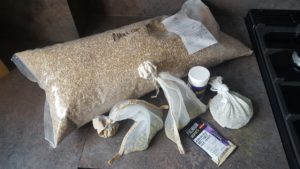Description
Obviously, I had to include the ubiquitous American IPA recipe. Most craft beer drinkers enjoy a nice, hoppy American IPA – it’s usually the biggest seller at any taproom.
American IPA styles are normally less malty than this version, and you could always substitute the Vienna and Carapils for more Maris Otter if you want something a bit paler and with less of a malty backbone.
Anyway, I’ve made this a few times. Because I like drinking it, obviously.
Ingredients
Base Malts:
- Crisp Extra Pale Maris Otter Malt (EBC 2.5-3.5)[4Kg]
- Crisp Vienna Malt (EBC 5.0-9.0)[1Kg]
Caramel Malts:
- Weyermann Carapils Malt (EBC 2.5 – 6.5)[0.4Kg]
Flaked Malts:
- Crisp Torrified Wheat (EBC 2.5-4.5)[0.5Kg]
- Crisp Flaked Torrified Oats[0.5Kg]
Hops:
- Citra t90 Hop Pellets 2018 (Alpha Rating 12.8%) [198G]
- Columbus t90 Hop Pellets 2018 (Alpha Rating 15.3%)[28G]
Dried Yeast:
- Lallemand BRY-97 West Coast Ale Yeast[Quantity:1]
Instructions
To make my wort, as always I’m using the BIAB (Brew in a Bag) method.
1. Fill your boiler with 25 litres of water, and heat to 69°c, so that your strike temperature ought to be the desired 67°c by the time I’ve added all my grain.
2. Add the grain bill slowly, stirring constantly to break-up any dough balls.
3. Check the temperature of your mash once all the grain’s been added. If it’s above 67°c add some ice or cold water, or sterilised ice packs until your mash is back down to 67. If it has dropped below 67 (more likely), heat it back up to temperature.
4. Put the lid on tightly, and hold the grain/water mix at 67°c for one hour. It’s advisable to check back on it every 15 – 20 minutes, giving a good stir and checking that the temperature is holding ok. It’s fine to heat it again to get the temperature back where it needs to be. As the weather’s getting colder, an outdoors-y emergency insulation blanket may be helpful to hold your temperature.
5. After one hour of mashing, remove the grain bag, drain it and squeeze it. I’ll pour a couple of litres of water through it at this point, to try and catch more of the malty goodness.
6. Next, get your wort to the boil, and once it is there, you’ll start your hop additions!
7. Divide your hops into hop socks:
- 28 grams of Columbus
- 28 grams of Citra
- 85 grams of Citra
(Keep 85 grams of Citra aside, in airtight packaging, in the freezer for dry hopping in a week’s time.)
8. The first hop addition is your 28 grams of Columbus, which you’ll add immediately. This hop addition is for bitterness. It will lose most of its flavour and aroma after an hour of boiling.
9. After 40 minutes, add your second hop addition, 28 grams of Citra. This addition is for flavour.
10. Boil for a further 15 minutes, and add half a whirlfloc tablet. Boil for another five minutes, and turn off the heat.
11. Start cooling your wort using wort chiller. Once the wort temperature is between 71°c and 76°c is (as in most cases) the best window for adding your third hop addition, 85 grams of Citra.
12. Continue cooling your wort until it gets down to an appropriate temperature for pitching your yeast. Here is a good time to start sanitising your fermentation vessel, hydrometer, etc, and also to rehydrate your yeast, according to the instructions on the packet.
13. Transfer cooled wort into your sanitised fermentation vessel, checking its temperature, and making a note of its OG (Original Gravity). If the temperature is down to around 25°c, you’ll be fine to pitch your rehydrated yeast. Pop the lid on, with airlock, and leave to ferment for seven days.
14. Time for dry hopping. This is where you’ll get most of the hop aroma. Two things – if the hops are pellets it is fine to add them straight to the fermentor, but if they are whole leaf hops, you’re advised to put them in a hop sock, with a small weight such as a ball bearing. Secondly, you don’t want to leave your dry hopping hops in your wort for too long. More than five days can cause grassy flavours, so if you won’t get a chance to package your beer by then, delay your dry hop addition accordingly.
15. After around ten days, your beer should be good to bottle or keg.
Notes
Grain Bill: 6.4kg
Mash: 1 hour at 67°c
Boil: 1 hour
Hop Additions: 28g Columbus at 60 mins; 28g Citra at 20 mins, 85g Citra at whirlpool; 85g Citra dry-hopping
Original Gravity: 1.066
Final Gravity: 1.016
ABV: 6.58%
Keywords: Hoppy, American, IPA, All-Grain

